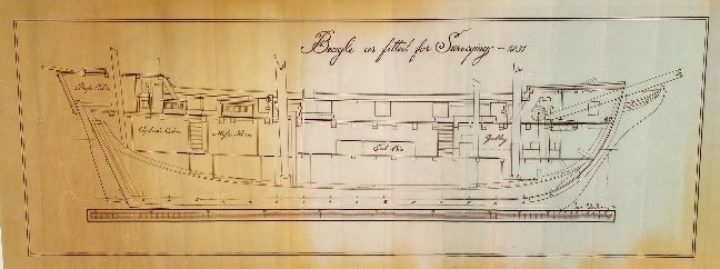Lois Darling’s Beagle
Archivist Alex Milne examines the history of HMS Beagle through the enthusiasm and diligence of artist, Lois MacIntyre Darling
Published on 1st October 2022
With the relative comforts, cost and ease of travel in the modern day our understanding of the experience of a journey in the pre-automated age is often muddled. The current popularity of period dramas and cottagecore romanticism offers us a glorified view of days gone by with smooth rides and billowing sails, meanwhile the ever-present gritty realism in media focuses on cramped, dark spaces, reeking of men and infested with rats who are often the least of the haunted looking crew's problems. In amongst all these bonnets and blackguards, sometimes, a ship can tell its own incredible story, simply through its construction. HMS Beagle is an excellent example of this phenomena and The Linnean Society archive holds several items relating to her travels including the work of a little known artist, determined to tell her story.
New York born Lois MacIntyre Darling, an author, illustrator, and accomplished yachtswoman became involved in research on HMS Beagle for the centenary of Darwin's Origin of Species, in 1959. Darling had won the 1941 National Women's Sailing Championship and during the Second World War she had been able to combine her passions by creating models of warships [1].
So it was no surprise that, in drafting plans for the Beagle, she became fascinated by her complex structural history. Along with models of the ship, which Darling built for institutions such as the American Museum of Natural History, she created beautifully detailed drawings showing its layout, the changes made to the original designs, and the inner workings. All of these slowly picked apart the Beagle's history.

Charles Darwin's famous trip to survey the southern coasts of South America, was the second major voyage for HMS Beagle. She was one of over 100 Cherokee class brig-sloops (a ship with two square-rigged masts), built with 10 guns and an emphasis on manpower economy to combat the growing lack of able seamen in a time when British naval supremacy was an important symbol of pride for the empire. These vessels were built as warships. Cherokee's carried powerful short range cannon and had the highest ratio of firepower to tonnage of any ship in the Royal Navy at the time.
Why am I telling you this, other than the fact that it's cool and I really like ships? While Cherokee class ships never really caught on (they were commonly referred to as “coffin brigs” as many sunk due to deck flooding on turbulent ocean crossings), it turned out they were, inadvertently, well suited for the survey trip. They were small and swift, the economy of manpower meant less crew were needed, so carrying extra passengers and supplies didn't interfere with day-to-day maintenance. She was also light and could operate in shallow water as well as deep, so while she could make the long, arduous trip across the ocean she could also navigate closer to the shore of the mainland and islands the survey captured.
Even so HMS Beagle required some major changes to the original design before she set off on her first survey, which are depicted in Darling's drawings. This 1825 voyage required her cannon to be reduced from ten to six, also a forecastle was added to deflect the blows of heavy waves out at sea to keep them from flushing the deck, and a mizzen mast (a smaller mast at the back of the ship) improved her handling (Technically this also changed her type from a brig to a bark).
The then Captain, Pringle Stokes, reported that all of this did little to stop the deck from being flooded so before the second voyage, which would carry Darwin on his travels, further improvements were required. Beagle was docked for extensive rebuilding, gaining a new raised upper-deck and additional sheathing. However, it would seem that these also failed to solve the issue as even Darwin refers to ship by yet another nickname, “half tide rock”[2]. Opposingly, John Lort (later Admiral) Stokes, who travelled on the Beagle for almost eighteen years and took part in all three survey expeditions, was full of praise for the ship and said she was, “in all kinds of weather, an excellent sea boat”[3].
Beagle plans on display in The Royal Society, Summer Exhibition 2022
Another addition to HMS Beagle, which can be seen in the drawings, was a brand new lightning conductor invented by Sir William Snow Harris to counteract the damage caused to ships by lightning storms out at sea.[4] The Beagle marked one the first successful tests of the lightning conductor and Darwin relates hearing about the mechanics of the invention while breakfasting with Harris, to his sister in one of his many letters.
Lois Darling became so fascinated by the story of HMS Beagle that she would go on to research and write a book on the ship H.M.S. Beagle: Further Research, or Twenty Years a-Beagling (1977) which proved so detailed that it is often referred to by historians and artists attempting to recreate the ship with her many modifications.

As for HMS Beagle herself, minor repairs were made before her third major voyage, another surveying trip around the coast of Australia between 1837 and 1843, then she was brought home to be refitted as a static coastguard watch vessel and an HM Customs and Excise ship. During this time her name was changed to the less catchy W.V. No.7 and after a period getting on the nerves of local oyster traders, in1870 she was sold on to be broken up. But she lives on, depicted in films and television shows, paintings and cartoons, and in Lois Darling's work.
The Linnean Society holds two of Darling's HMS Beagle drawings (DWC/6/1 and DWC/6/2), gifted to the society by the Charles Darwin Trust in 2015. They are currently on display in The Royal Society's Summer Science exhibition.
Alex Milne, Archivist
